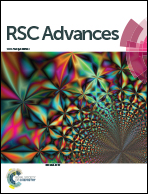Processing and characterization of ZnO nanowire-grown PBO fibers with simultaneously enhanced interfacial and atomic oxygen resistance properties†
Abstract
The surface of poly(p-phenylene benzobisoxazole) (PBO) fibers was modified by Zinc oxide nanowires (ZnO NWs) using a mild hydrothermal method to enhance the interfacial properties of PBO fiber/epoxy composites. A functionalization technique was developed to improve the bonding between the PBO fiber and ZnO NWs and was validated by X-ray photoelectron spectroscopy (XPS). Energy dispersive spectrometry (EDS), X-ray diffractometry (XRD), transmission electron microscopy (TEM), scanning electron microscopy (SEM), atomic force microscopy (AFM), wettability testing and single fiber tensile testing were performed to characterize the hybrid fibers. The quantitative relationships between the process parameters (solution concentration ratio and growth time), structure and interfacial shear strength (IFSS) of ZnO NW-grown PBO fibers were systematically investigated. Moreover, the possible interfacial property enhancing reasons were explored. Experimental testing showed that the ZnO NWs interphase developed here offered a significant increase in the IFSS (increased by 50.7%) without degrading the base fiber. It was also shown for the first time that dense ZnO NWs could serve as barriers to protect the PBO fiber underneath from atomic oxygen (AO) erosion, which resulted in their potential applications.


 Please wait while we load your content...
Please wait while we load your content...